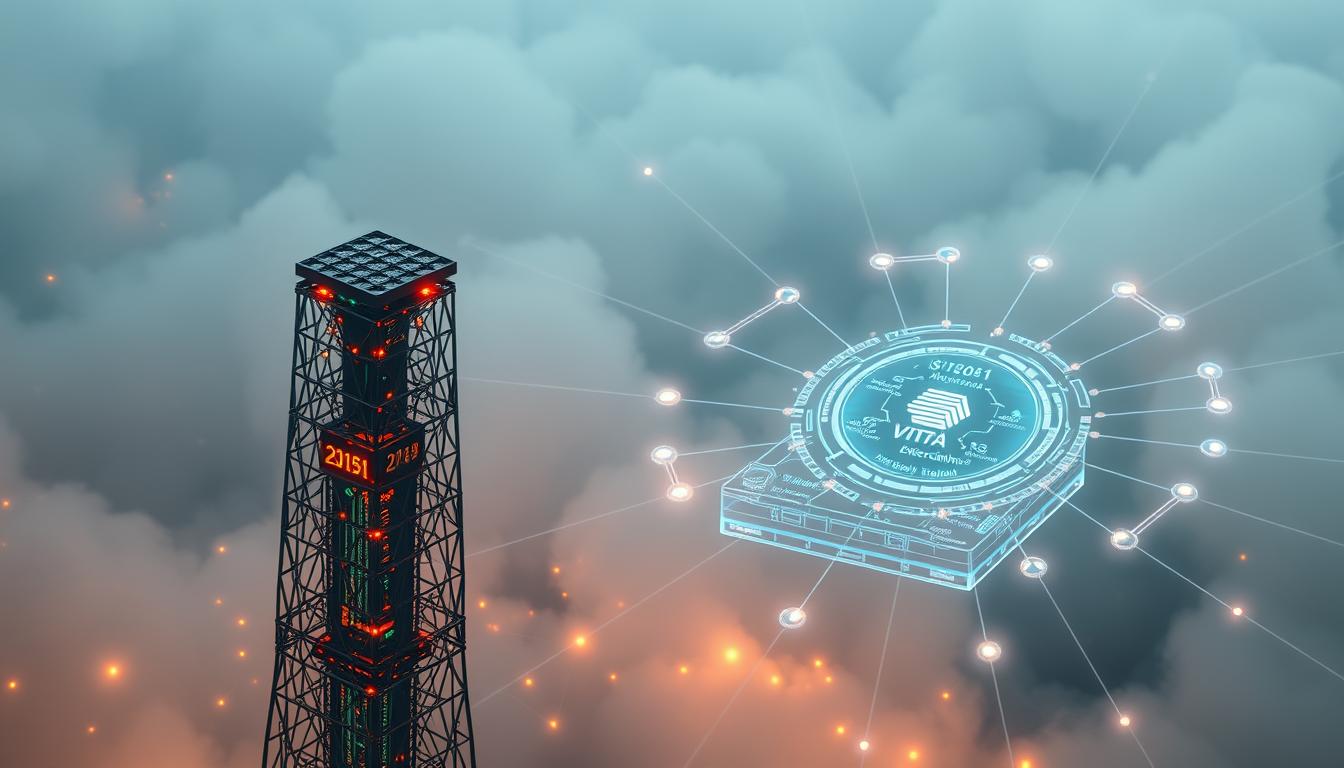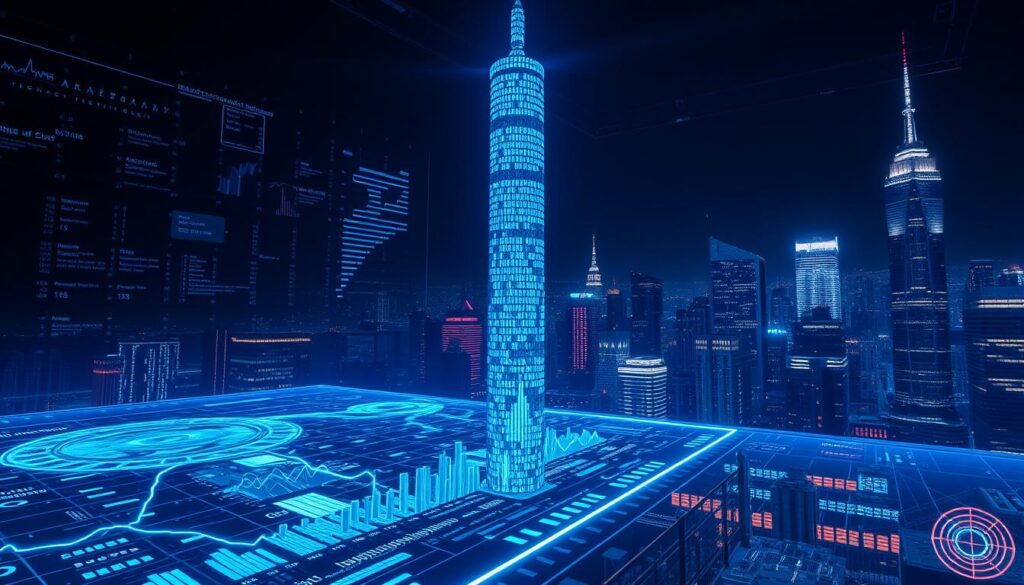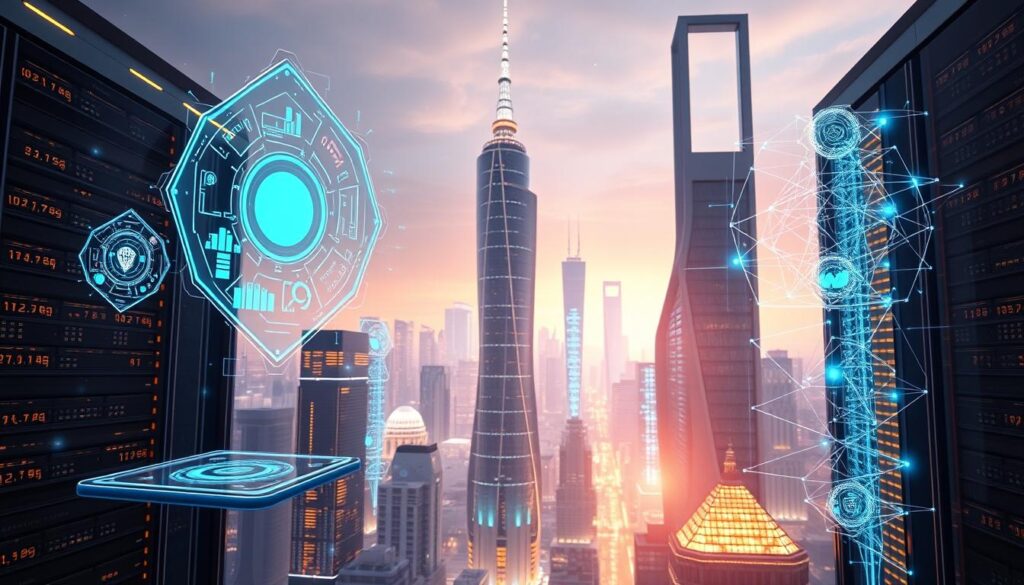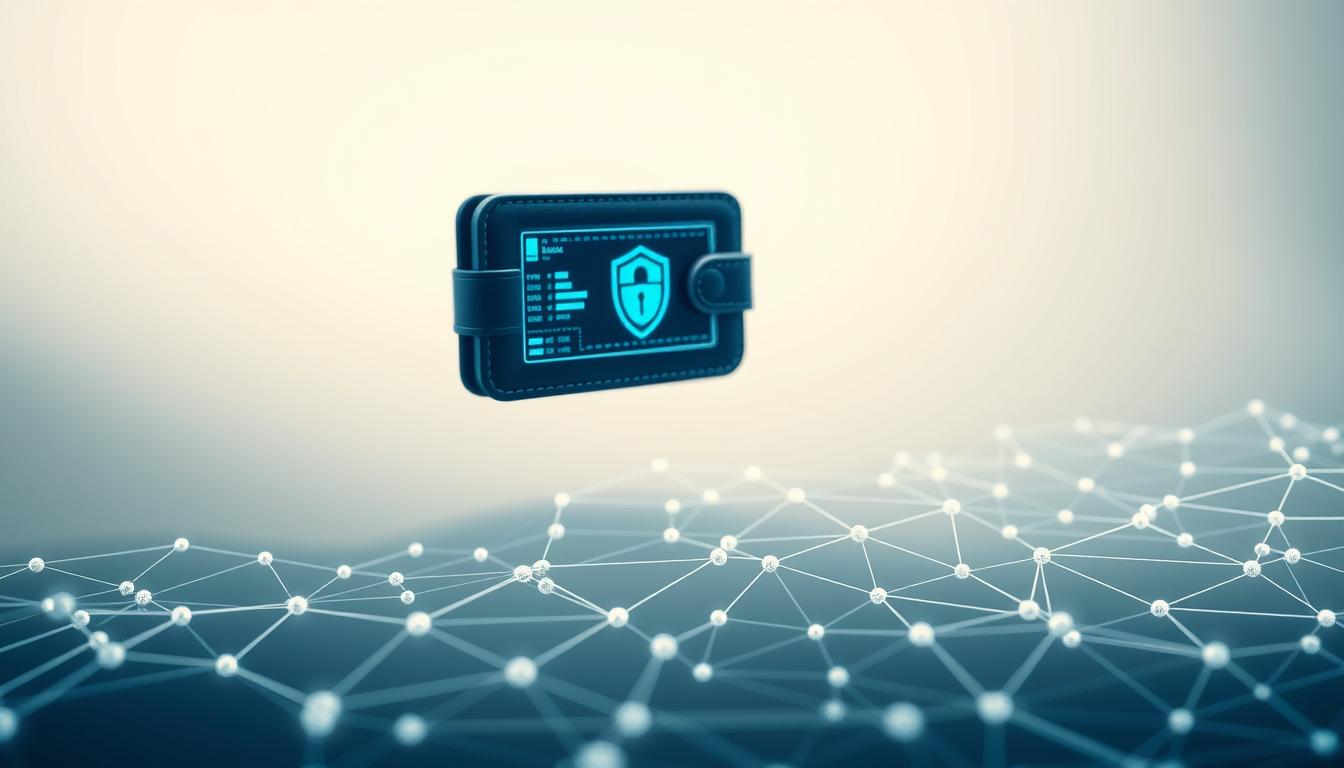Now Reading: Understanding AI Blockchain Oracle Data Validation
- 01
Understanding AI Blockchain Oracle Data Validation
Understanding AI Blockchain Oracle Data Validation

Smart contracts are powerful tools that run on their own secure digital ledgers. However, they operate in a closed environment. This creates a major challenge known as the “Oracle Problem.” These contracts cannot natively see outside information like stock prices or weather reports.
This is where specialized services called oracles become essential. They act as bridges, fetching facts from the real world and delivering them to the blockchain. This allows contracts to execute based on verified, off-chain events.
The integration of advanced computational intelligence is transforming these services. Simple data relays are becoming smart verification networks. They can analyze and confirm information before it ever reaches a contract. This guide will explore how these intelligent oracles work in blockchain systems.
We will cover the fundamental concepts and technical strategies. You will learn about real-world applications and best practices. The goal is to help developers build more reliable and informed decentralized applications.
Key Takeaways
- Smart contracts are isolated and cannot access external information on their own.
- Oracles serve as critical bridges between blockchains and the outside world.
- Advanced intelligence transforms data delivery into smart verification.
- These enhanced systems tackle major challenges like data accuracy and security.
- This technology enables smarter, more reliable decentralized applications.
- Understanding these concepts is vital for future development in this space.
Introduction to AI and Blockchain Oracles
Autonomous contract systems face a critical challenge: they cannot natively perceive events occurring outside their native environment. This isolation creates a significant gap between decentralized networks and the dynamic real world they aim to serve.
Bridging the Gap Between Decentralized Systems and Real-World Data
Specialized services called oracles serve as essential connectors between isolated ledger systems and external sources. They fetch verified information from various off-chain providers and deliver it to self-executing agreements.
These intermediaries transform simple data relays into intelligent verification networks. Advanced computational methods enable them to analyze and contextualize information before it reaches contract execution.
| Oracle Type | Primary Function | Common Applications | Data Sources |
|---|---|---|---|
| Software Oracles | Connect to online APIs | Price feeds, weather data | Web services, databases |
| Hardware Oracles | Interface with physical sensors | Supply chain tracking | IoT devices, scanners |
| Inbound Oracles | Bring external data on-chain | Event triggers, conditions | Multiple external sources |
| Outbound Oracles | Send blockchain data outward | Payment confirmations | External systems, APIs |
Overview of Smart Contracts and Data Feeds
Self-executing agreements depend entirely on the quality and accuracy of their information streams. Without reliable data feeds providing verified real-world facts, contracts cannot execute actions related to external events.
The integration of intelligent verification mechanisms creates more robust systems. This capability enables autonomous agreements to respond to actual occurrences and automate complex business logic across various applications.
Understanding the Role of Blockchain Oracles in AI Systems
The digital backbone of decentralized applications requires a reliable connection to the physical world. These specialized intermediaries serve as critical bridges that enable autonomous agreements to respond to actual events.
Connecting Real-World Data with Decentralized Applications
Modern applications need access to diverse information streams to function effectively. These services fetch verified facts from multiple external sources and deliver them securely to on-chain systems.
This capability transforms simple code into responsive systems that can adapt to changing conditions. The integration of various information channels creates more dynamic and useful applications.

Integration of APIs, IoT Devices, and Off-Chain Databases
Web service interfaces allow these intermediaries to pull real-time facts from financial markets and weather systems. This expands the scope of possible use cases dramatically.
Physical sensors provide another valuable stream of environmental measurements. Temperature, location, and energy consumption readings can trigger contract execution based on actual conditions.
Traditional organizational databases represent a third crucial source. Supply chain records and customer information can be accessed without migrating sensitive details to public networks.
The combination of these multiple independent sources creates robust verification networks. This multi-source approach helps ensure accuracy and reliability for critical applications.
AI Blockchain Oracle Data Validation: Fundamentals and Best Practices
Modern computational agreements depend heavily on the quality of external inputs they receive. Establishing robust verification processes ensures these systems operate with maximum reliability and effectiveness.
Ensuring Data Integrity and Accuracy
Maintaining information quality requires multiple verification layers. Cryptographic techniques create secure transmission channels that prevent tampering during transit.
Advanced analytical models enhance traditional checking methods. They identify unusual patterns and cross-reference facts against expected ranges.

Consensus Mechanisms and Reputation Systems
Distributed validation involves multiple independent nodes fetching the same information. They use voting algorithms to determine the most accurate value before submission.
Performance tracking systems assign trust scores based on historical accuracy. Contracts can then weight information from proven sources more heavily.
| Validation Approach | Primary Function | Key Benefits | Implementation Complexity |
|---|---|---|---|
| Multi-Source Consensus | Aggregate inputs from independent providers | Reduces single point failures | Medium |
| Cryptographic Verification | Ensure information integrity during transmission | Tamper-proof security | Low to Medium |
| Reputation Scoring | Weight sources by historical performance | Continuous quality improvement | High |
| Statistical Analysis | Detect anomalies and outliers | Proactive error prevention | Medium to High |
Step-by-Step Guide to Implementing AI Oracle Integration
Building reliable bridges between external information sources and self-executing agreements requires a systematic implementation approach. This process involves careful coordination between ledger-native code and external computation systems.
On-Chain Versus Off-Chain Components for Oracle Setup
The implementation begins with clear separation of responsibilities. On-chain elements handle interface management and result verification. These components include reputation tracking and payment settlement systems.
Off-chain infrastructure focuses on information collection and analysis. This includes modules that connect to external APIs and perform quality checks. The two layers work together seamlessly.
Deployment Strategies and Smart Contract Configuration
A practical deployment approach starts with centralized testing. This allows developers to validate core functionality before scaling. Gradual transition to decentralized networks follows initial success.
Smart contract configuration requires precise parameter setting. Developers must define acceptable formats and establish timeout mechanisms. Fallback procedures handle service interruptions effectively.
| Implementation Approach | Primary Focus | Best For | Complexity Level |
|---|---|---|---|
| Centralized Initial Setup | Rapid testing and validation | Development phases | Low |
| Hybrid Transition Model | Gradual decentralization | Scaling applications | Medium |
| Full Decentralization | Maximum security and reliability | Production systems | High |
| Modular Component Design | Flexible service integration | Evolving requirements | Medium to High |
Real-World Use Cases for AI-Enabled Oracle Systems
Real-world adoption of smart verification networks showcases their transformative potential. These systems bridge digital agreements with physical world information across diverse sectors.

Multiple industries are leveraging these advanced intermediaries to automate complex processes. The practical applications demonstrate significant operational improvements.
Decentralized Finance, Trading, and Prediction Markets
Financial platforms represent major adoption areas for enhanced verification services. They require accurate price information for various assets to function effectively.
Trading systems utilize these networks to monitor price movements across exchanges. This helps identify opportunities and protect against market manipulation.
Prediction markets depend on reliable event outcome resolution. Enhanced systems gather information from multiple sources to determine accurate results.
Applications in Smart Cities, Agriculture, and Insurance
Urban implementations use sensor information to optimize municipal operations. Traffic management and energy distribution benefit from real-time monitoring.
Agricultural systems leverage weather and soil condition data for better farming decisions. This improves crop yields and resource management.
Insurance applications automatically process claims when specific conditions are met. Flight delays or weather events can trigger immediate payouts without manual intervention.
Overcoming Challenges in AI-Enhanced Oracle Deployment
Deploying advanced verification systems presents significant operational hurdles that require careful planning. These challenges span security concerns, performance requirements, and infrastructure demands.

Addressing Data Manipulation and Security Risks
Malicious actors often target information streams to trigger false contract executions. Strong cryptographic protocols help verify source authenticity and prevent tampering.
Distributed trust models reduce single points of failure. Multiple independent sources must reach consensus before information is accepted. This approach enhances security but requires careful coordination.
Scalability and Infrastructure Considerations
As demand grows, these systems must handle increasing requests while maintaining speed. Complex computational models require significant processing power and storage capacity.
Strategic architecture planning from the beginning prevents costly redesigns later. Modular designs allow components to evolve independently. Recent research on oracle protocols shows promising scalability solutions.
Performance monitoring ensures systems meet latency requirements for time-sensitive applications. Regular model updates maintain accuracy as conditions change.
Conclusion
Context-aware information processing represents the next frontier for self-executing contract systems. These advanced services transform how automated agreements interact with real-world events, moving beyond simple data delivery to intelligent interpretation.
Successful implementation requires careful planning around technical architecture and operational considerations. A phased approach with thorough testing ensures reliable results before full deployment. The future points toward increasingly sophisticated verification models.
Investment in robust infrastructure becomes essential as applications grow more complex. Proper security protocols and performance optimization will drive innovation across finance, insurance, and supply chain implementations. This integration creates more dynamic and trustworthy decentralized systems.
FAQ
What is the main purpose of an oracle in decentralized networks?
Oracles act as bridges, bringing external information from the real world onto a secure digital ledger. This allows self-executing agreements, known as smart contracts, to trigger actions based on verified events like weather conditions or stock prices.
How does artificial intelligence improve the trustworthiness of information from these services?
AI enhances reliability by analyzing patterns and detecting anomalies in incoming information feeds. It helps build robust reputation systems and consensus models among multiple sources, significantly reducing the risk of incorrect or manipulated inputs affecting outcomes.
In what practical scenarios are these combined systems most valuable?
They are crucial in decentralized finance (DeFi) for accurate price feeds, in parametric insurance for swift claims processing, and in supply chain management for real-time tracking. Other key applications include prediction markets and automated trading platforms that depend on high-quality, timely external data.
What are the primary security concerns when integrating external sources?
The main risks involve data manipulation and single points of failure. To counter this, best practices involve using multiple independent information providers and cryptographic proofs to verify the authenticity and integrity of the data before it is used by any contract.
What is the difference between on-chain and off-chain components in an oracle setup?
On-chain components are the smart contracts on the digital ledger that receive and use the information. Off-chain components are the external systems that gather data from the real world. The off-chain part fetches and potentially processes the information, while the on-chain part makes it available for decentralized applications to consume securely.















